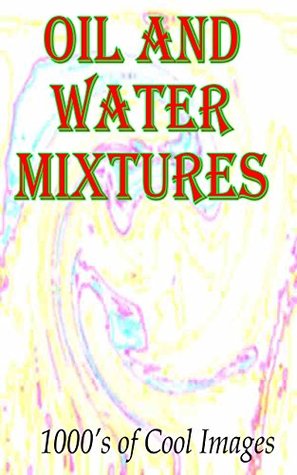Read Oil and Water Mixtures : 1000's of Cool Images - Collins Grenville | ePub
Related searches:
Oil and Water Mixtures : 1000's of Cool Images – Booksliced.com
Mix It Up with Oil and Water - Scientific American
Why Don't Oil and Water Mix? Wonderopolis
Emulsions: When Oil and Water Do Mix - IFT.org
US4938876A - Method for separating oil and water emulsions
Oil/water separation techniques: a review of recent progresses and
Oil and Water - YouTube
Emulsions: making oil and water mix
Amazing Experiment With Oil and Water How to Mix Oil
Oil and Water Experiment - The Best Ideas for Kids
10 Heterogeneous and Homogeneous Mixtures
1.4H: Water, Sand, and Oil Baths - Chemistry LibreTexts
Oil and Water Questacon - The National Science and Technology
Mixing Oil and Water – Woods Hole Oceanographic Institution
Is Matter Around Us Pure Class 9 Extra Questions and Answers
OIL AND GREASE LIMITS - TN.gov
Experimental Determination of Flow Patterns and Water Holdup
Add a few drops of food coloring to the water and stir until combined. Securely tighten the lid on the jar and shake it for 15-20 seconds.
*if you use school glue instead of white glue, the putty will not bounce or pick up print from the newspaper. You will need: 3 cups flour� 1 cup salt; 3 tablespoons vegetable oil; 1 cup water; the children can help measure and mix the flour and salt.
Jun 23, 2004 for starters, oil is a complicated mixture of hundreds, sometimes thousands, of chemicals.
An emulsion is a temporarily stable mixture of immiscible fluids, such as oil and water, achieved by finely dividing one phase into very small droplets. Common emulsions can be oil suspended in water or aqueous phase (o/w) or water suspended in oil (w/o). There also can be more complex systems, such as oil in water in oil (o/w/o).
Do try this amazing experiment at home on mixing oil and water.
The oil always floats to the top because it is less dense than water. Oil and water don’t mix because water molecules are more attracted to each other than to oil molecules. When you add the detergent, one end of each a detergent molecule attaches to a water molecule and the other.
Apparatus for continuously separating oil, water and solids from stable mixtures thereof, also includes the step of adding a flocculant prior to cooling the mixture� throughout capacity, developing a separation force over 1000.
Aircooled specific oil has special properties to help cool the engine. If the oil advertises it works for both i would imagine it should. I know a logger that uses cheap outboard oil in all his saws and has for over 5 years with no problems.
May 24, 2018 unlike many other substances such as fruit juice, food dyes or even sugar and salt, oils do not mix with water.
Oil, non-biodegradable cutting oil, or products of mineral oil origin in amounts that will cause interference or pass through. However, the federal regulations are silent on other types of oils and greases and very few cities have regulations that specify limits and enforcement of oil and grease (lipids) discharges from restaurants.
For example, if your mix ratio is 8:1 or 8 parts water to 1 part solution, there are (8 + 1) or 9 parts. Need another example? if your mix ratio is 4:1 or 4 parts water to 1 part solution, there are (4 + 1) or 5 parts.
Of water in oil and semi-water annular flow, intermittent flow of water and dispersion of water in oil semi-annular and dispersion of water in oil and water annular flow. Therefore, this paper presents its findings on the flow pattern and water holdup of a typical low viscosity oil-water two-phase flow in horizontal pipes, simulated.
54: a) boiling water bath, b) water bath to cool an apparatus, c) heating a flask with a sand bath, d) allowing a flask to cool. Oil baths are much like water baths, but use silicone or mineral oils in order to enable temperatures hotter than the boiling point of water ( \(100^\texto \textc\)).
What would you observe when (a) a saturated solution of potassium chloride prepared at 60°c is allowed to cool to room temperature? (b) an aqueous sugar solution is heated to dryness?.
Craig's homework, 21/6/14find out what happens when you mix water and cooking oil together.
Hs: v (of two or more substances) (v (of single substance)! total v of the mixture) x 100 * pour 100 ml of the mixture into the 100 ml graduated cylinder and let the mixture settle. � calculate the volume of water and the volume of oil in your 100 ml container.
Then, pour in 1 tsp of neem oil into the soapy water a little at a time. Stir the mixture or shake the spray bottle after each addition to ensure the oil disperses through the water. Spray the mixture onto the leaves and stems of your plants, as well as onto the ground around their roots.
Have you ever heard the saying, “oil and water don't mix”? for this easy science experiment, we observe exactly.
These special colloids (another type of mixture) have a mixture of oils and waters. As time passes, the oil and water will separate, because emulsions are mixtures.
These examples represent emulsions, which are stable mixtures of tiny droplets of one immiscible fluid within another, made possible by chemicals called emulsifiers. Simple emulsions are either oil suspended in an aqueous phase (o/w), or water suspended in oil (w/o).
The viscosity of oil can be ten times greater than water, increasing the energy required to pump oil for cooling, and reducing the net power output of the engine. Comparing air and water, air has vastly lower heat capacity per gram and per volume (4000) and less than a tenth the conductivity, but also much lower viscosity (about 200 times lower.


Post Your Comments: